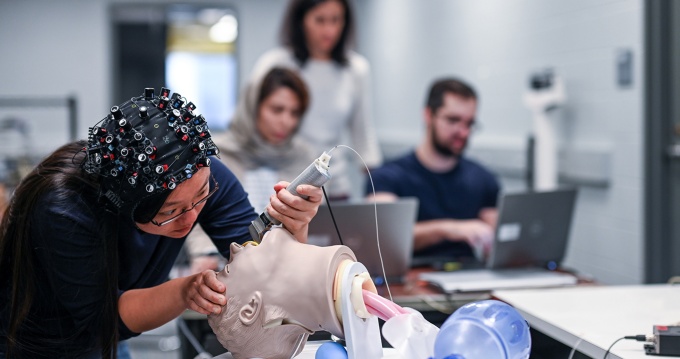Health and Health Systems
Our research in this area has focused on improving patient outcomes in robotic surgeries, modeling emergency operations in hospitals, rapid product prototyping and nano-manufacturing methods for biomedical engineering, modeling the functional abilities of wheeled mobility device uses for rehabilitation engineering, and injury risk reduction to promote health.

Sponsors include the Emergency Medicine Foundation, U.S. Department of Health & Human Services Agency for Healthcare Research and Quality, National Institute for Occupational Safety and Health, U.S. Army, National Institute for Disability and Rehabilitation Research, U.S. Department of Justice United States Access Board, New York State Department of Health, Mercy Hospital of Buffalo, Saint Vincent Health Center, Greatbatch Technologies, Delphi Harrison, and Motorola Incorporated.
Affiliated Faculty
Selected Research Topics
Hospital Modeling and Analysis for Emergency Operations in Hospitals
This research has concentrated on such things as use of computer simulation models for the real-time estimation of hospital capacity after a disaster. Using historical data, generic hospital models are developed for the estimation of steady-state and dynamic capacity in a disaster situation, e.g., earthquake.
Rapid Prototyping and Nano-Manufacturing
This research applies rapid prototyping techniques in biomedical engineering for the fabrication of artificial tissues, bones, implants, and biomedical devices. In some applications, three-dimensional biomedical models are created from CT scan or MRI data and biomedical objects are then fabricated using rapid prototyping techniques directly from the computer-aided model of a biomedical object. Other applications involve the use of nano-manufacturing technologies to fabricate nano-scale objects, sized less than 100 nm. Computational geometry is used to solve the complex geometric problems associated with the prototyping.
Work and Communication in Robotic Assisted Surgery
Robotic Assisted Surgery has improved patient outcomes but has created new challenges related to automation interaction, team communication and opportunities for new medical errors. This research activity to improves workflow, layout, and inter-team communication in RAS in order to improve cognitive and physical workload of surgical team members, reduce operative time, improve surgical outcomes, and minimize the chance of surgical error.
Better Design of Health IT
This research includes studies of physician nurse communication in emergency medicine in order to develop shared situation displays; assessing the impact on health data exchange and interoperability on workflow in primary and specialty care practices; developing methods to insure robust implementation of safety critical health IT systems; and cognitive engineering design and analysis (through field study and simulator based laboratory studies) of electronic patient tracking systems being implemented in hospital emergency departments to understand their usability and impact on work practice and situation awareness.
Modeling of Wheeled Mobility Device Users
This research has developed the largest database of functional abilities and body dimensions of wheelchair users in existence. The work includes the use of new anthropometric methods that record 3-dimensional coordinates of body dimensions, the collection of functional and structural anthropometric data, and development of design tools including 3-D human models for use by rehabilitation engineers, architects and standards makers.
Injury Risk Reduction to Promote Health
Research projects have focused on how to reduce the biomechanical risk factors for work-related musculoskeletal disorders during various tasks such as lifting, office workstation tasks and manufacturing tasks via the use of engineering controls in order to promote health in working adults. Research has applied bioinstrumentation and biomechanical modeling/analysis methods to understand the injury mechanism to develop efficient control methods.